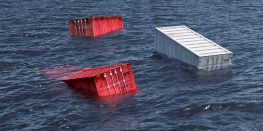
How do Shipping Containers End Up in the Water?
April 6, 2021
In the commercial shipping industry, shipping containers form the bulk of cargo transport operations. These simple steel boxes, ranging in size from 10 feet long to over 50 feet in length, are used to safely transport goods from production and manufacturing centers to retailers worldwide. Unfortunately, thousands of these shipping containers are lost to the ocean depths each year, resulting in millions or even billions of dollars in business losses. Commercial marine insurance protects against the risks associated with cargo damage or loss in transport. Understanding why and how these containers fall overboard can help supplement the risk protections of commercial marine insurance, ensuring cargo is delivered safely to end users.
Cargo Containers: A Brief Overview
Although their history stretches back to the mid-18th century, the modern shipping container was developed in the 1950s to facilitate intermodal transportation. Prior to standardization, containers took many forms and sizes, often leading to inefficiencies in loading, unloading, and transport. An American inventor and entrepreneur set out to improve cargo handling efficiency by creating a standardized container that could be used on ships, carried by rail, and loaded onto truck trailers for easy transport.
Modern shipping containers come in five standard lengths:
- 10 foot
- 20 foot
- 40 foot
- 45 foot
- 53 foot
Shipping containers are typically made of steel, providing enhanced cargo security and improved protection against damage. They can be configured to carry bulk goods such as vehicles, consumer items, and equipment or may be equipped with refrigeration units for climate-controlled shipping of goods produced by agricultural and pharmaceutical operations. Today, these containers transport about 90% of the world’s cargo, making them essential for the commercial shipping industry.
Losing Containers at Sea
Every year, environmental and safety factors combine to cause the loss of cargo containers during ocean voyages. While these losses are relatively rare, incidents can end up costing shippers millions of dollars and necessitate the protection of commercial marine insurance. In a single incident in early 2021, a cargo ship operated by A.P Moller-Maersk lost an estimated 750 cargo containers during rough weather. A similar incident in November 2020 caused the loss of 2000 containers when a ship operated by Ocean Network Express encountered storms off the coast of Hawaii. This incident resulted in insurance claims exceeding $220 million.
Cargo ships plying the world’s waterways are becoming larger. Some of the largest container ships may carry as many as 24,000 cargo containers. The loss of one container at sea can result in steep financial losses; if a storm or other event causes dozens or even hundreds of containers to fall overboard, the situation can create financial devastation that even the most robust commercial marine insurance policy would be difficult to cover.
Factors Leading to Container Losses at Sea
Cargo containers falling overboard can result in significant financial losses, but may also put human lives, vessels, and the environment in jeopardy. How are these containers lost at sea? As ships become larger, containers may be stacked on deck to maximize cargo loads. This can lead to problems with stability; a catastrophic event known as “parametric rolling” can cause ships to pitch up and down while rolling from side to side. If the condition cannot be controlled, cargo containers may become unfastened from their tiedowns and lost overboard. This condition can occur even in waterways that are not experiencing high wave activity.
Storm activity is another leading cause of container losses. If a ship encounters severe winds and waves, containers may shift violently or be swept overboard. Still other containers are lost due to equipment failures or human error during loading and unloading operations. To minimize cargo losses, technologies such as roll sensors and weather warning systems have been adopted by the maritime industry. Redundant safety checks during cargo handling and while underway can also help to reduce the damage or losses associated with cargo container incidents.
To protect ships and their cargo assets from losses, commercial marine insurance provides a robust risk management solution. With this insurance and with a focus on cargo container safety, shippers can continue to deliver goods to world ports while protecting vessels and financial assets.
About Merrimac Marine Insurance
At Merrimac Marine, we are dedicated to providing insurance for the marine industry to protect your clients’ business and assets. For more information about our products and programs, contact our specialists today at (800) 681-1998.
